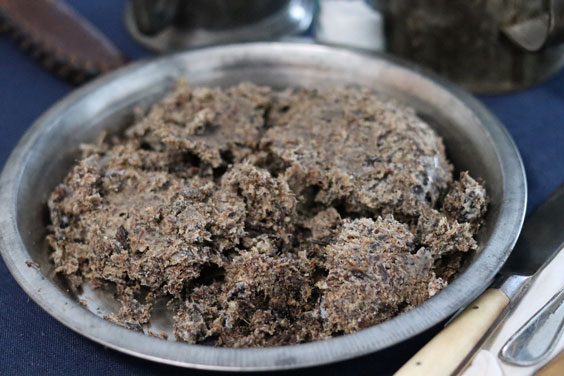
When fresh, pemmican has a waxy, gritty texture and a fatty, beefy flavor. While pemmican can store indefinitely if kept dry, its flavor does not improve with age.
Pemmican is a food made of a mix of dried meat and fat. As George Colpitts notes in his book, Pemmican Empire: Food, Trade, and the Last Bison Hunts in the North American Plains, 1780-1882, the name came from the Cree word pemigan and means “he makes grease.” The grease came from bone marrow and was mixed with harder fats by Native Americans to produce traditional pemmican, sometimes referred to as sweet pemmican.
Two types of pemmican were commonly made foods. Sweet pemmican consisted of a mixture of more palatable fats, including bone marrow grease and unsaturated fats, which made it softer and more palatable than its more prolific counterpart, trade pemmican. It was prepared with care using the best meat and fat. Dried fruit was sometimes mixed into it. For instance, in the Red River Valley, the highbush cranberry, also known as the Pembina berry, would have been added.
Trade pemmican, by contrast, was a hurriedly mass-produced food made by Euro-American and Métis fur traders from whatever was most accessible. It contained more saturated fats and was thus much harder. It often contained other ingredients such as fur, bits of bone, or even bark, which inadvertently found their way into the mix during processing. Despite its rough and unappealing taste and texture, the calories packed into every pound of pemmican helped to drive the fur trade.
Fur traders first came to Pembina in the 1790s to hunt beavers. By 1804, they switched to hunting bison for meat and making pemmican to feed fur traders who operated in the far north of Canada. The Métis quickly took over the pemmican industry, dominating in the middle 19th century with their annual bison hunts at Pembina and Walhalla, then called St. Joseph. Pemmican was so important to feeding people working and living in the Red River Valley that in 1814 the Pemmican War broke out between competing fur trade companies and their allies when the governor of the British territory of Assinaboia (modern southern Manitoba and the Red River Valley) tried to forbid its export. The pemmican trade, like much of the industrial fur trade, ended when bison herds were hunted to near extinction in the late 19th century, a problem exacerbated in part by intensive bison hunts of the Métis pemmican trade.
Despite reading about pemmican in the accounts of many writers who described it in varying degrees of admiration or derision, I still didn’t know what it tasted or looked like. So I embarked on some experimental archaeology to find out. Having no easy access to bison bones, I made a version of trade pemmican, though I left out the fur and bark. I used beef fat since the butchers near me did not carry bison fat. Though bison was historically the most common meat base, pemmican can be made with the meat and fat of any animal, even wild game or fish.
I started with dried bison, which to me tasted almost flavorless but slightly gamey. Adding some beef fat, the dish tasted like fatty ground beef with only a hint of the bison, but the texture is that of a wax candle mixed with gravel. That may not sound appealing, but at almost 4,000 calories per pound, pemmican couldn’t be beat as a source of shelf-stable nutrition in the 19th century.
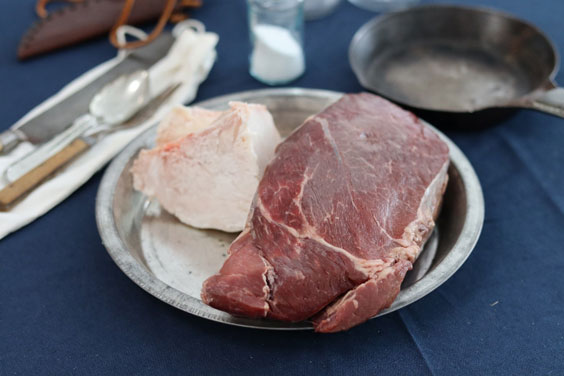
Two pounds of raw meat and a ½ pound of suet. The meat will reduce to a quarter of its weight when dried, leaving ½ pound of dried meat and ½ pound of suet for 1 pound of pemmican.
If you are up for an adventure and want to make your own pemmican, you’ll need only two or three ingredients:
- 2 pounds of raw meat (bison or beef), as lean as can be found
- ½ pound of suet or fat (bison or beef)
- 1 cup of finely chopped dried fruit (optional)
Begin by cutting the meat into strips as thin as possible. Cut against the grain to make the meat dry faster and easier to pulverize later. Lay the cuts of meat on a wire rack. Place the rack on a baking sheet to catch any errant fat drips.
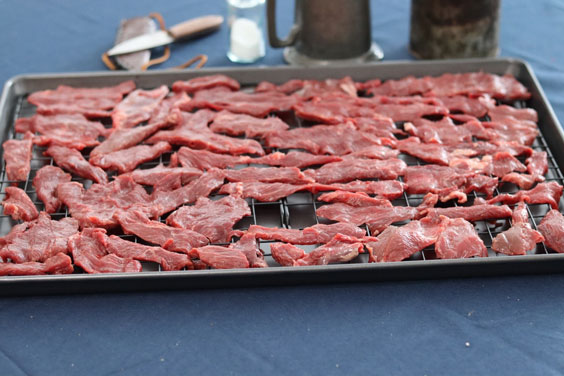
Cut against the grain to dry the meat faster and make it easier to grind.
Set your oven to the lowest possible temperature—for me that was 175 degrees Fahrenheit. Bake the tray of meat in the oven for 10 to 12 hours. The historical method of drying meat was to hang it outside in the sun for one or two days. The hot sun and prairie winds would desiccate the meat and dry it into jerky. Smoke and fire were sometimes employed to aid the drying process. A more hygienic option is to use an oven or dehydrator.
The dried meat should be brittle and tear apart easily. Place the dried meat in a food processor or blender and use the pulse setting until the meat is mostly ground into a stringy powder; a few remaining small chunks are fine. The longer you process the meat, the finer it will become, which will improve the texture of the final product. If you are including dried fruit, now is the time to mix it thoroughly into your ground meat.
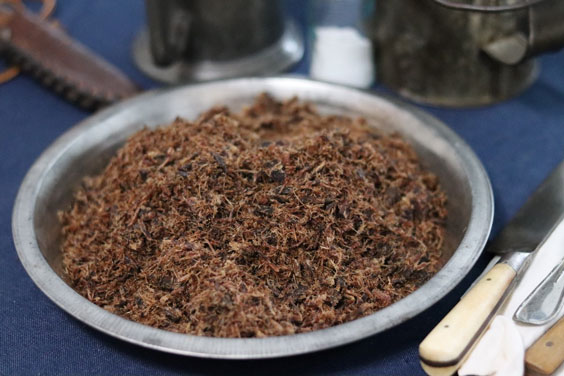
Grind as fine as you wish. Sweet pemmican would have been made with meat pounded into a literal powder. Trade pemmican would have been rougher, which is what I ended up making here.
Next render the fat in a saucepan over medium-low heat. With a metal strainer or spoon, remove any chunks that do not melt so only liquid fat is left. Pour the fat mixture over your ground meat and begin mixing it together with a spoon. Once cool enough to touch without burning your hand, begin mixing by hand to cover everything thoroughly in fat. It is best to wear gloves while mixing. After mixing, but before the fat has set, you may choose to pour your pemmican into a muffin tin or other shaped dish. Let the mixture rest until it has fully hardened.
Pemmican when kept dry has a shelf life measured not in months or years but in decades, though added fruit will shorten it. Historically, pemmican was stored in bags made of bison hide with the seams sewn with rawhide and coated in tallow to keep air and moisture out. A freezer bag or plastic container will suffice to store your pemmican. You may choose to refrigerate your pemmican, but it is not necessary. I made a bag from rabbit fur purchased at the Pembina State Museum store, and my pemmican has kept without refrigeration for over a year. The pemmican is still gritty and a bit unpleasant to my taste buds but completely edible and should remain so for many years.
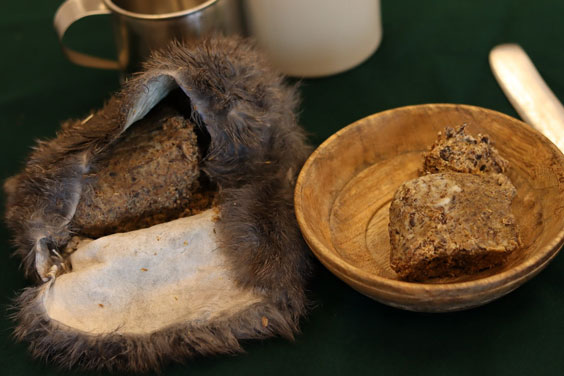
For added flare, I bought a rabbit fur and sewed it into a pocket to more authentically store my pemmican. You may prefer a plastic freezer bag.

